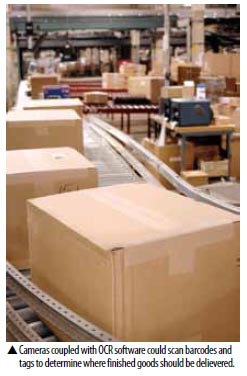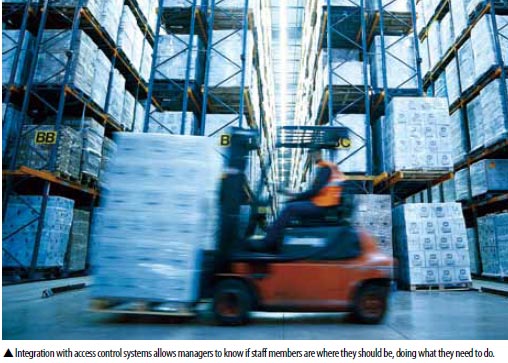Cost Savings
 Access control reduces the need for manned security gates inside the facility itself. This enables workers to access their secured work areas slowing them down. For distributed access control systems, on-site card printing is made available. This allows each site to be less dependent on the centralized system, benefitting from predefined central access rules while also maintaining a level of flexibility.
Access control reduces the need for manned security gates inside the facility itself. This enables workers to access their secured work areas slowing them down. For distributed access control systems, on-site card printing is made available. This allows each site to be less dependent on the centralized system, benefitting from predefined central access rules while also maintaining a level of flexibility.
Enhancing Productivity
According to Niederberger, productivity in industrial facilities can be increased through access control solutions in many ways:
For instance, integrated time and attendance makes it quicker to identify which worker is absent. This is important for critical manufacturing processes, where special training, certification or skills are required. Through integration with the HR system and skill databases, it is possible to seek out backup operators immediately.
Furthermore, access control integrated with MES helps managers track and log equipment maintenance, with details recorded centrally of who did the maintenance, what was done and whether it was done in due time. “This functionality is crucial in specialized manufacturing, where manufacturing equipment failure could lead to quality issues in the finished products, such as for aircraft manufacturing,” Niederberger said.
Productivity improvements can also be linked to safety. This is particularly true when it is essential to account for everyone during an evacuation, such as those on mining sites. “The full evacuation of the zone for a planned blast has to be conducted and verified as part of mining safety regulations,” Niederberger continued. “A useful application of access control is therefore one where card readers are installed in the buses that drive mining operators away from the danger zone, with workers registering their presence inside the bus through badging. It is worth noting that a similar functionality can also be used for emergency evacuation purposes, such as on oil platforms or in chemical plants, where access control badging can be used at emergency assembly points to account for people.”
Finally, a key aspect of productivity is increased fiscal transparency. “Access control on equipment or production lines enables for more accurate production accounting by providing exact internal cost allocations, exact machine utilization statistics or identifying how much time a worker spent on a certain process compared to a benchmark,” Niederberger added. “It can also help reduce energy use, such as cutting power to unused equipment. The same is true for time allocation for external resources. Access control can help track the time of arrival and departure of contractors to check against service level agreements and delivery performance targets.
Preventing Loss
 Access control plays an obvious role in preventing losses caused by theft, vandalism or sabotage. In addition, it can also prevent untrained operators from damaging sensitive or expensive equipment, Lim said.
Access control plays an obvious role in preventing losses caused by theft, vandalism or sabotage. In addition, it can also prevent untrained operators from damaging sensitive or expensive equipment, Lim said.
Furthermore, access control provides an additional means of controlling stock. Efficiency and accountability are further increased when paired with RFID technology. This makes it easier to monitor when and how many specific items were taken out of stock, and by whom.
Access control systems that enable visitor and contractor management functionality provide better control over who is actually on the site, and who is their host. They also make available escort functionality that ensures visitors are do not wander around on their own.
A centralized system that is integrated with the HR system enables quick activation or deactivation of access rights, based on staff changes. This prevents former employees from accessing the site or using equipment, while enabling new employees to be fully operational quickly.
Complying to Regulations
Health and safety benefits from access control systems. Access control can ensure only trained personnel operate in or around dangerous areas or machinery, reducing the risk of workplace accidents and thereby the number of lost workdays, Niederberger said. “This not only directly impacts compliance achievements, but can also reduce nonconformance rates of manufactured goods, which is particularly relevant in highly specialized and regulated manufacturing industries.”
Access control systems can be configured to register and verify certain criteria before allowing individuals to enter controlled areas. “There was one case where the client needed this functionality to comply with safety regulations, as some staff and contractors may not have attended the relevant safety courses,” Lim said. “However, there are also cases where we needed to deny access to staff who did not have the relevant certifications for required skill sets.”
Compliance is simplified by understanding the compliance requirements prior to the selection and design of security infrastructure. “That way, the infrastructure can be designed specifically to meet the compliance requirements completely and efficiently,” McCaughey said. “This is far more efficient and less costly than trying to meet compliance requirements after installation of systems and having to compensate for inadequacies.”
Although compliance with safety and health regulations is touted in many businesses, many do it as a “paper” exercise, Lim warned. “By merely putting coordinators or managers to check on noncompliance is a process that had failed often and is merely for documentation and retrospective actions. We often remind business owners that if a real accident occurs, there might be loss of lives and have many undesirable and unforeseen consequences for the business. Putting physical checks by security systems can certainly improve all-year-round consistency in the enforcement of compliance.”